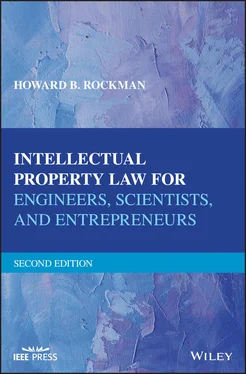Since there is a requirement, even after the AIA, that the detailed description of the patent application set forth the “best mode” of the invention contemplated by the inventor at the time the application is filed, you must ensure yourself that the best mode is set forth in the application. This requires that if you have performed additional work on the invention while the patent attorney was preparing the patent specification, you must add the additional material to the application after the application has been drafted and furnished to you for review and comment. Keep in mind that a “best mode” of the invention discovered one day after or at any time subsequent to the filing of the application is of no consequence. That “mode” can be covered in a subsequently filed continuation‐in‐part patent application.
The patent specification also points out features of the subject invention that produce the previously described advantages, and which comprise improvements over the prior art. This again is part of the “sales” presentation advising the Patent Examiner how the invention differs from past technology. The specification can also point out how your invention solves a long‐standing problem or need in the prior art. This will reinforce the argument that the invention was not obvious to one skilled in the art.
Upon reviewing the patent application once it is completed by the patent attorney, satisfy yourself that the description of your invention is correct, complete, and is set forth in a logical, flowing manner. The description of the structure should be in an easy‐to‐understand format, and the statement of operation or function should also be logical, starting, for example, from an input and working through to the output, or from the beginning of the operation to the end.
Also, when reviewing the patent application submitted to you by the patent attorney, determine whether you believe that the Patent Examiner, when he or she reads the application, will determine instantaneously that there is an invention described in the patent application. Also, ensure that the patent attorney has adequately defined all of the novel features of your invention.
To obtain a filing date for the patent application, it must be filed with the USPTO with at least one claim, all the pages of the specification, and all the drawings. If any one of these elements is omitted, no filing date will be assigned to the application.
If you determine from reading the prior art obtained through a pre‐filing patentability search that the Patent Examiner may make an argument of lack of novelty, or obviousness based on the prior art, the patent application specification should anticipate these arguments and furnish rebuttal information in the specification itself. Therefore, when reviewing the patent application, be sure that you understand the differences between your invention and the disclosures of the prior art of which you are aware.
In the patent specification, technical details such as dimensions, angles, materials of construction, circuit components, values‚ and the like may be omitted, unless they are critical to the novelty or understanding of the invention. However, all details critical to the practice of the invention must be set forth. Again, my recommendation is to err on the side of inclusion if you cannot determine the essentiality of all details. Also, remember that if your issued patent is ultimately subjected to enforcement in a court of law, the ultimate reader of the patent may be a federal judge and/or jury who have no technical knowledge whatsoever. Therefore, when reviewing the patent application, review it from the standpoint that some day a nontechnical person may have to determine the scope and content of the invention described in the issued patent.
The specification must also include sufficient information to enable a person skilled in the art to make and use the invention. If it is found that the specification is not complete, or describes an inoperable invention, the issued patent ultimately could be held to be unenforceable. It has been my experience that a properly prepared patent application is a finite merger of proper technical disclosure and description, and excellent and artful use of the English language, all applied to technology.
The description portion of the patent specification concludes with a general statement of intent not to restrict the invention to the precise embodiments described, but to have the patent cover any device or process that falls within the scope of the claims that are ultimately allowed by the Patent Examiner.
9.6.7 Claims Distinctly and Precisely Pointing Out the Definition of the Invention
As a preface to Chapter 10, which discusses patent claims in detail, it suffices to say that the claims of a patent application should be written broadly enough to cover any competing device or process that may be marketed in the future, and at the same time narrowly enough so they do not cover, or “read on,” the prior art. The construction of the claims usually turns on the combined efforts of the inventor and the patent attorney, working in conjunction to ensure that the fine line of invention over the prior art is adequately and precisely defined.
The USPTO rules require that the patent application include an “Abstract of the Invention” of not more than 150 words, briefly describing the novel features of the invention. The Abstract is reprinted on the first page of the issued patent, which is normally called the Information Page. The purpose of the Abstract is to provide the reader with the “heart” of your invention in a few concise sentences. Usually, the patent attorney will divide the broadest claim of the patent application into a series of short sentences, which eliminate the “legalese” of the broad claim. By reading the Abstract, one reviewing the issued patent should be able to decide if they desire to read further.
It is important that the Abstract be worded with the same degree of care as the rest of the patent application. In at least one reported decision, the Court of Appeals of the Federal Circuit (CAFC) has referred to the Abstract in deciding to limit the scope of claim coverage of a patent.
9.7 YOUR REVIEW OF THE PATENT APPLICATION
Once the patent application is prepared by the patent attorney, the application is forwarded to the inventor for the inventor’s review and comment. Once the application is correct in all details, the inventor signs a Declaration or Oath, wherein the inventor declares that he or she believes himself or herself to be the first original and sole or joint inventors of the subject matter of the application.
Upon reviewing your completed patent application, you must ensure that the invention has been adequately and broadly described, and that the claims adequately cover the invention to the extent permitted by the content of the prior art. If, upon your review, you determine that a competitor can “design around” your broad claims, advise your patent attorney, who will suggest adding even broader claims to the application to cover your “design around” embodiment. I refer to this analysis as having the inventor assume the role of “devil’s advocate” vis‐à‐vis the claims of the patent application.
I advise my clients that we, as patent attorneys, have no pride of authorship, and therefore the inventor can make any and all additions, changes‚ or comments they deem necessary. If the patent attorney concludes that certain of these recommended changes by the inventor may add limitations to the patent application rather than broadening the scope, he or she will then discuss these proposed changes with the inventor. Ultimately, once the patent application is approved by both the inventor and the patent attorney, the formal documents supporting the application are signed, and the application is filed with the USPTO to await examination.
Читать дальше












